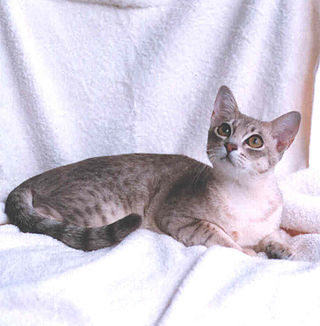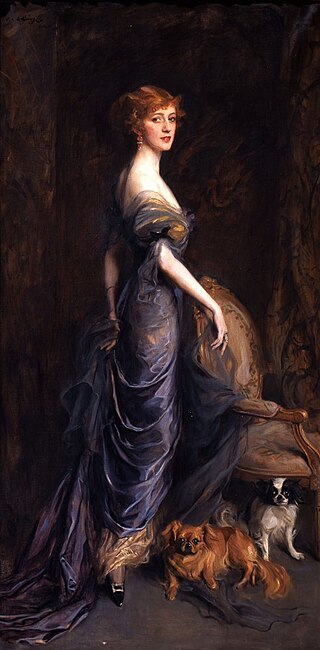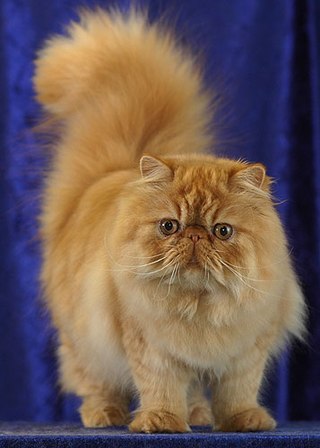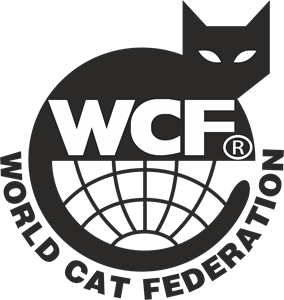
The Bengal cat is a domesticated cat breed created from a hybrid of the Asian leopard cat, with domestic cats, especially the spotted Egyptian Mau. It is then usually bred with a breed that demonstrates a friendlier personality, because after breeding a domesticated cat with a wildcat, its friendly personality may not manifest in the kitten. The breed's name derives from the leopard cat's taxonomic name.

The Australian Mist is a breed of cat developed in Australia. It is a cross between the Abyssinian cat, the Burmese cat, and the Australian Tabby cat.

The Scottish Fold is a distinctive breed of domestic cat characterised by a natural dominant gene mutation associated with osteochondrodysplasia. This genetic anomaly impacts cartilage throughout the body, causing the ears to "fold", bending forward and down towards the front of the head. While this trait contributes to the breed's unique appearance, often described as an "owl-like", it is essential to note that osteochondroplasia can have negative effects on the cats' welfare.

The Munchkin, also known as Sausage Cat, is a breed of cat characterized by its very short legs, which are caused by genetic mutation. Compared to many other cat breeds, it is a relatively new breed, documented since 1940s and officially recognized in 1991. The Munchkin is considered to be the original breed of dwarf cat.

The Siberian is a centuries-old landrace of domestic cat in Russia, and recently developed as a formal breed with standards promulgated the world over since the late-1980s. Since 2006, the breed is recognised for registry and championship status with all major cat registries.
Purebreds are "cultivated varieties" of an animal species achieved through the process of selective breeding. When the lineage of a purebred animal is recorded, that animal is said to be "pedigreed". Purebreds breed true-to-type which means the progeny of like-to-like purebred parents will carry the same phenotype, or observable characteristics of the parents. A group of purebreds is called a pure-breeding line or strain.

The Governing Council of the Cat Fancy (GCCF) is a cat registry, established in 1910 and the largest organisation that registers pedigree cats in the United Kingdom. It was formed from a small number of cat clubs which were registering cats at the time when the modern cat fancy was in its first stages. It is considered to be the original prototype for cat fancy registries. It is an independent body with around 150 member clubs, including specialist breed clubs and area clubs covering particular regions. The GCCF became an incorporated company on 5 November 2010. It licenses cat shows put on by its affiliated clubs with about 135 shows per year. Pedigree cats shown at these shows can gain the titles Champion, Grand Champion, Imperial Grand Champion and Olympian. The latter having three levels, Bronze, Silver and Gold. The word Champion is replaced by Premier for neutered cats, and Master Cat for cats competing in household pets. The showing of non-pedigree cats and Pedigree Pets is also popular at GCCF shows.

The Fédération Internationale Féline (FIFé) is a federation of cat registries. There are currently forty-two member organizations in forty countries. Membership spans Europe, South America, and Asia. FIFé is one of the nine members of the World Cat Congress.
A cat registry or cat breed registry, also known as a cat fancier organization, cattery federation, or cat breeders' association, is an organization that registers domestic cats of many breeds, for exhibition and for breeding lineage tracking purposes. A cat registry stores the pedigrees (genealogies) of cats, cattery names, and other details of cats; studbooks, breed descriptions, and the formal breed standards ; lists of judges qualified to judge at shows run by or affiliated with that registry, and sometimes other information. A cat registry is not the same as a breed club or breed society. Cat registries each have their own rules and usually also organize or license (sanction) cat shows. The show procedures vary widely, and awards won in one registry are not normally recognized by another. Some registries only serve breeders, while others are oriented toward pet owners and provide individual as well as cattery memberships, while yet others are federations only deal with breed clubs or even other registries as intermediaries between the organization and breeders.

The Canadian Cat Association is a non-profit organization in Canada whose mission is to promote the welfare of all cats in Canada, maintain a registry of pedigreed cats in Canada, and further the improvement of all breeds of cats in Canada. CCA-AFC is Canada's only globally-recognized national cat registry, with its pedigrees and registrations accepted by major global associations such as the Cat Fanciers' Association, The International Cat Association, and Fédération Internationale Féline. To date, CCA-AFC has registered over 190,000 cats.

Traditional Persian is one of several names for a group of cats that are considered to be essentially the original breed of Persian cat, before the variety was selectively bred to have extreme features. Other everyday usage names are: Doll Face Persian, Classic Persian, Old Fashioned Persian, Long-nosed Persian, Old-style Longhair, Traditional Longhair and Original Longhair.

Animal fancy is a hobby involving the appreciation, promotion, or breeding of pet or domestic animals.

The Minuet is a hybrid mix of Persian and Munchkin cat breeds. Categorized by The International Cat Association (TICA) as a domestic hybrid, "developed from a deliberate cross between two existing domestic breeds, incorporating characteristics of both parental breeds into the new mix." The Minuet cat is characterized by its short legs, as a result of the dwarfism-mutation similar to the Munchkin cats.

The Persian cat, also known as the Persian longhair, is a long-haired breed of cat characterised by a round face and short muzzle. The first documented ancestors of Persian cats might have been imported into Italy from Khorasan as early as around 1620, however, this has not been proven. Instead, there is stronger evidence for a longhaired cat breed being exported from Afghanistan and Iran from the 19th century onwards. Widely recognised by the North-West European cat fancy since the 19th century, and after World War II by breeders from North America, Australia and New Zealand. Some cat fancier organisations' breed standards subsume the Himalayan and Exotic Shorthair as variants of this breed, while others generally treat them as separate breeds.

Cyprus cats, also known as Cypriot cats, Saint Helen cats, and Saint Nicholas cats, are a landrace of domestic cat found across the island of Cyprus. A standardized breed is being developed from them; among cat fancier and breeder organizations, it is presently fully recognized by the World Cat Federation (WCF), with breeding regulated by the World Cat Congress (WCC), under the name Aphrodite's Giant; and provisionally by The International Cat Association (TICA) as the Aphrodite. All three organizations permit shorthaired and semi-longhaired versions and no out-crossing to other breeds.

The Australian Cat Federation (ACF) is an Australian organisation created in 1972. Its goal is to better the breeding of cats, to recognise new breeds, and to keep standards and rules regarding competitions.

The World Cat Federation (WCF) is an international association of cat clubs. It was founded in 1988 in the city of Rio de Janeiro, and continues to have a strong presence in Latin America, Western Europe, and in countries of the former USSR. It is currently based in Germany. There are 370 organizations worldwide associated to the WCF. The current president is Anneliese Hackmann from Essen.















